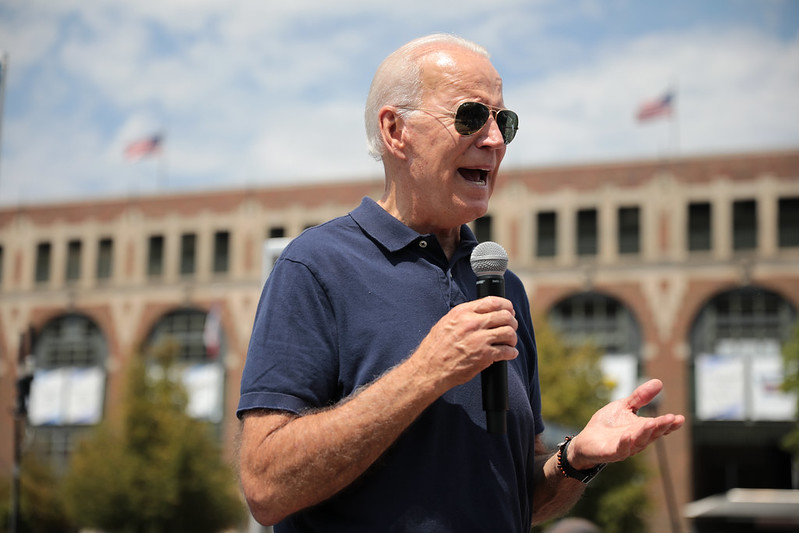Biden’s silent climate victory lap
The president talks up his climate laws without saying “climate.” Can the U.S. meet its climate goals without telling voters about them?

Well, we finally got a real “Infrastructure Week.”
President Biden has been traveling from Baltimore to New York to Kentucky, touting his major legislative achievements in front of trains, tunnels and bridges. He’s talking up both the Infrastructure Investment and Jobs Act (IIJA) and the Inflation Reduction Act (IRA) as a warm-up for his State of the Union speech on February 7. In these speeches, Biden talks about speeding up commutes and creating jobs. And even when he mentions the new funding to build “charging stations” he refrains from uttering the words “electric vehicles.”
Biden is taking a victory lap for his landmark climate laws without saying the word “climate.”
Both laws are, of course, big climate achievements. The IRA provides $369 billion for climate and clean energy programs, the largest investment of its kind ever passed by Congress. It could shrink the country’s carbon emissions by roughly 40% by 2030. The bi-partisan IIJA is a nearly $1 trillion package that includes billions for clean energy infrastructure.
Now, it’s not a surprise that Biden is taking this victory lap without dwelling on the “c” word.” It’s tradition. From Nixon to Clinton to Obama, the consensus has held that environmentalism doesn’t lend itself to reelection campaigns. And it’s not a surprise, because both IRA and IIJA were designed––and branded––as economic measures on purpose.
But this strategy, along with some fresh polling, could spell trouble for meeting U.S. climate goals. That’s because most Americans have no idea there are billions of climate change-related tax credits and rebates that they can benefit from, like right now.
In fact, one in three registered voters (33%) have heard “nothing at all” about the IRA. That’s one big finding from the latest report called “Climate Change in the American Mind,” put out by the Yale Program on Climate Change and George Mason University Center for Climate Change Communication. Of those who have heard about the IRA, only 8% associated the law with “climate and clean energy.” Maybe that’s the desired effect of passing a climate bill without calling it a climate bill. But what’s it mean for implementation?
Here’s the bigger problem revealed by that recent survey: Fewer than half of registered voters think the IRA “will help them or the country.” A measly 26% of registered voters think it will benefit their family. That includes 47% of liberal Democrats, 34% of moderate/conservative Democrats, 7% of liberal/moderate Republicans, and 3% of conservative Republicans. Yes, more than half of liberal Democrats think that the IRA will not benefit their family.
So, can the Biden administration make gains implementing the IRA if even liberal Democrats don’t know about the billions of climate-related tax credits and rebates? After all, that same group told pollsters that they support funding for renewable energy in huge numbers (98%) and that global warming is one of several important issues in deciding how to vote (77%).

White House advisors say they have a plan. They say they are working with states, contractors, retailers and social media influencers to make sure rebates and credits are front of mind for the American consumer at the moment they’re walking the aisle of Home Depot shopping for a new water heater or hovering their mouse over that ad for solar panels. Biden himself acknowledged the communication challenge during a recent Cabinet meeting when he was talking about the climate-friendly incentives.
“Folks need to know how to take advantage of these benefits that we passed,” Biden said. “That’s on all of us around the table here to make sure we get that message out clearly.”
That “all of us” includes the journalists who were present to cover that Cabinet meeting, whether Biden meant that or not.
Implementation of the IRA in communities and households around the country is one of the media stories to watch in 2023, not just for environmental reporters but for any newsroom. The nonprofit Rewiring America calculates that the IRA basically “creates an $8,000 bank account for every American household” to buy things like heat pumps, window retrofits, and electric vehicles, as longtime journalist and environmentalist Bill McKibben pointed out recently during a webinar organized by Covering Climate Now. He added that newsrooms around the country can help the cause by alerting their local audiences (and elected representatives) to all the funding available, and then tracking how well the money is used.
The polling by Yale and George Mason did have some good news for the Biden administration and anyone who cares about addressing the climate crisis: A majority of registered voters surveyed support building climate-friendly energy production and distribution in their local area: 61% when it comes to solar; 58% and 57% respectively for electric vehicle charging stations and wind farms; and 54% for high-voltage power lines.
So maybe, we’re not looking at “Infrastructure Week”, but rather “Infrastructure Year.”





Reader Comments